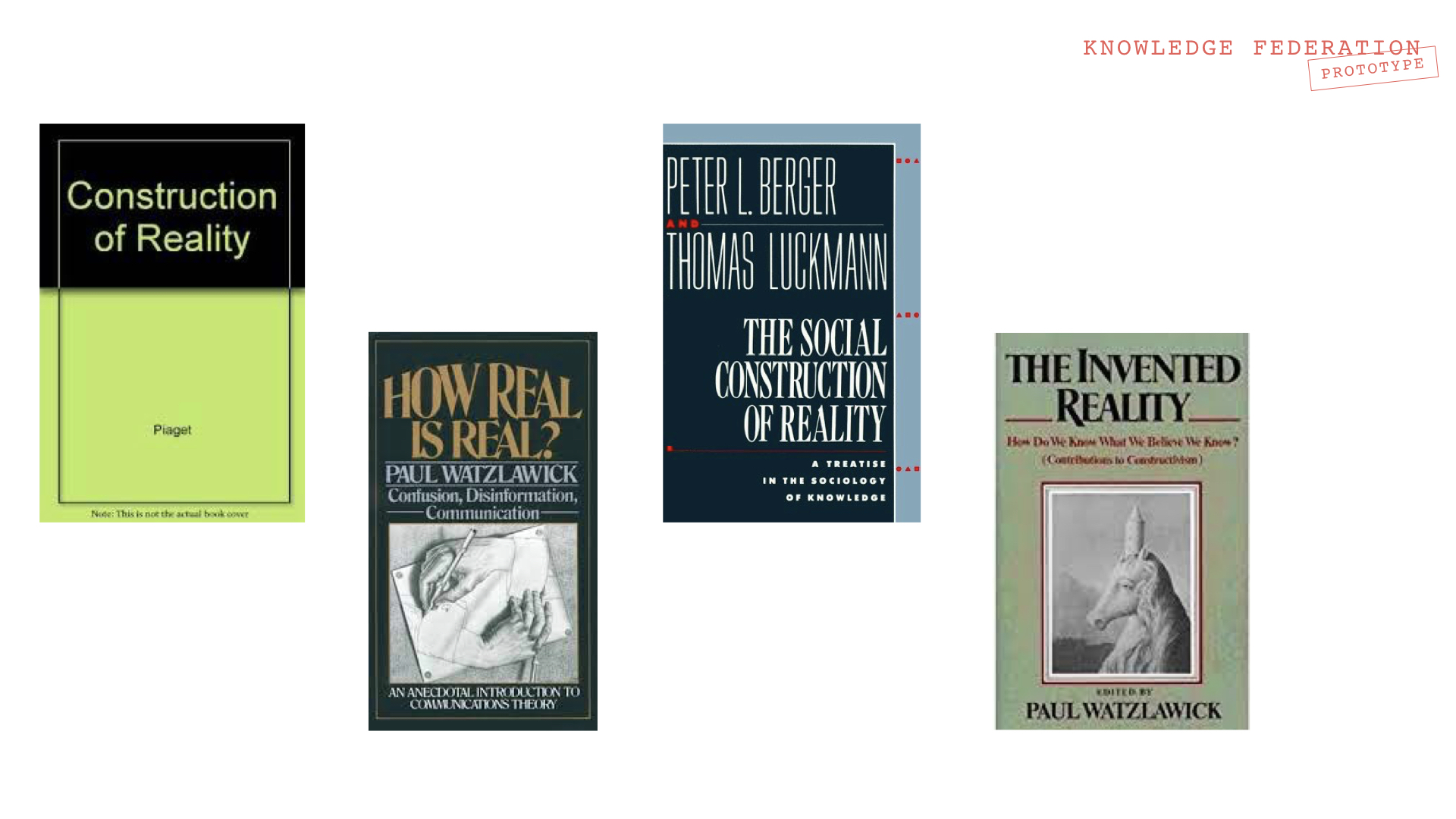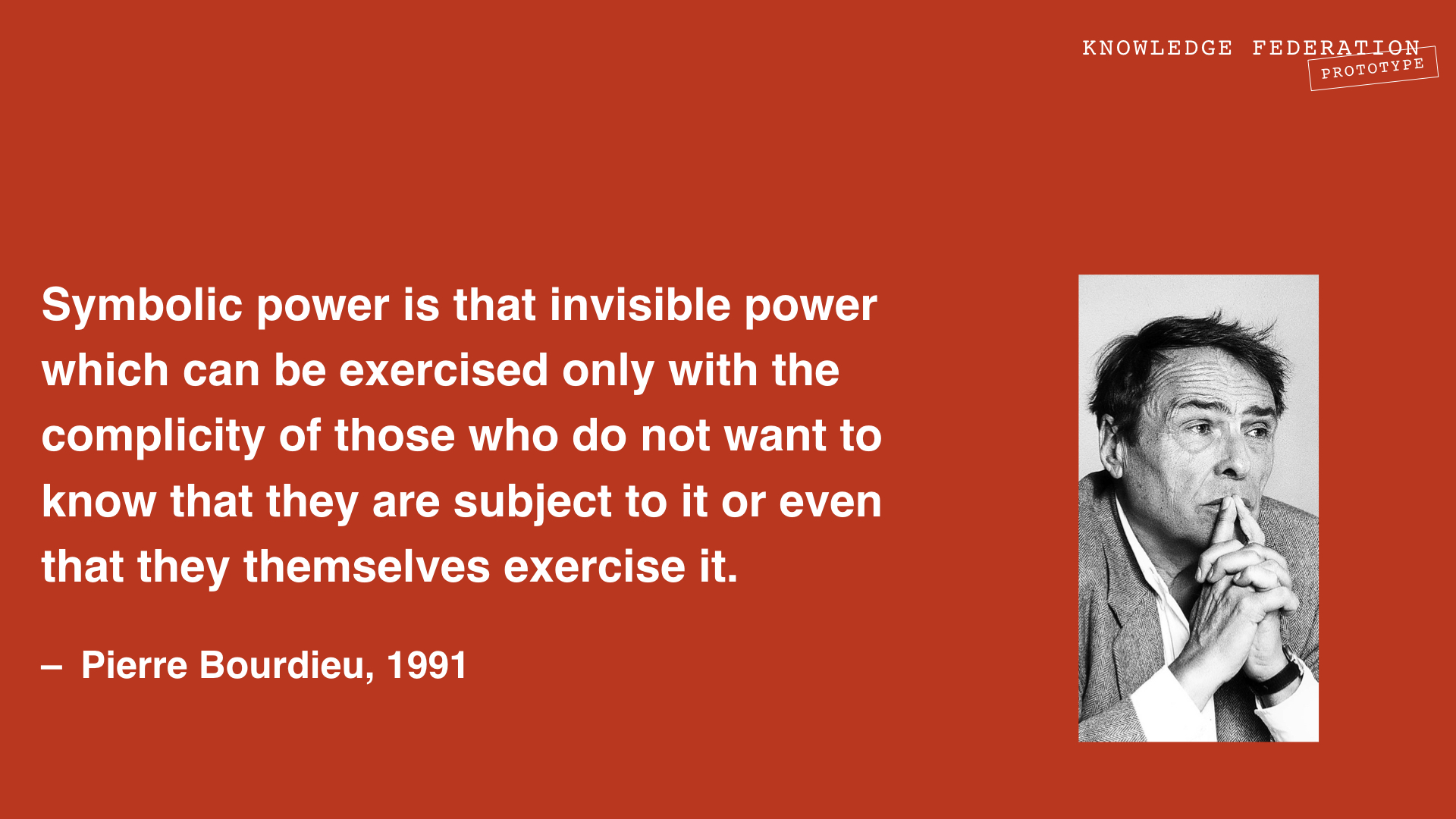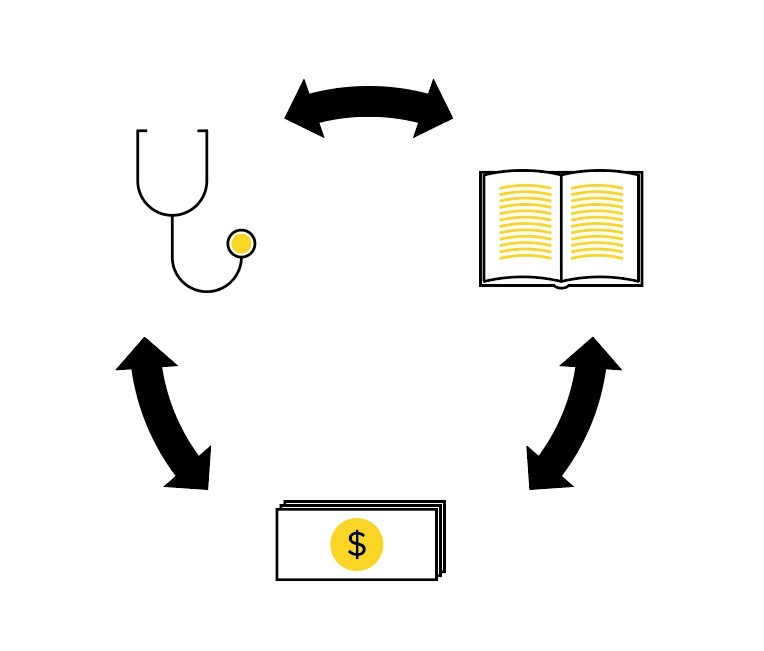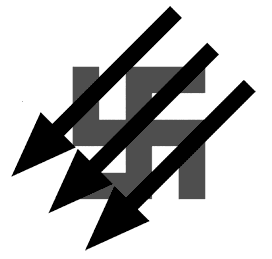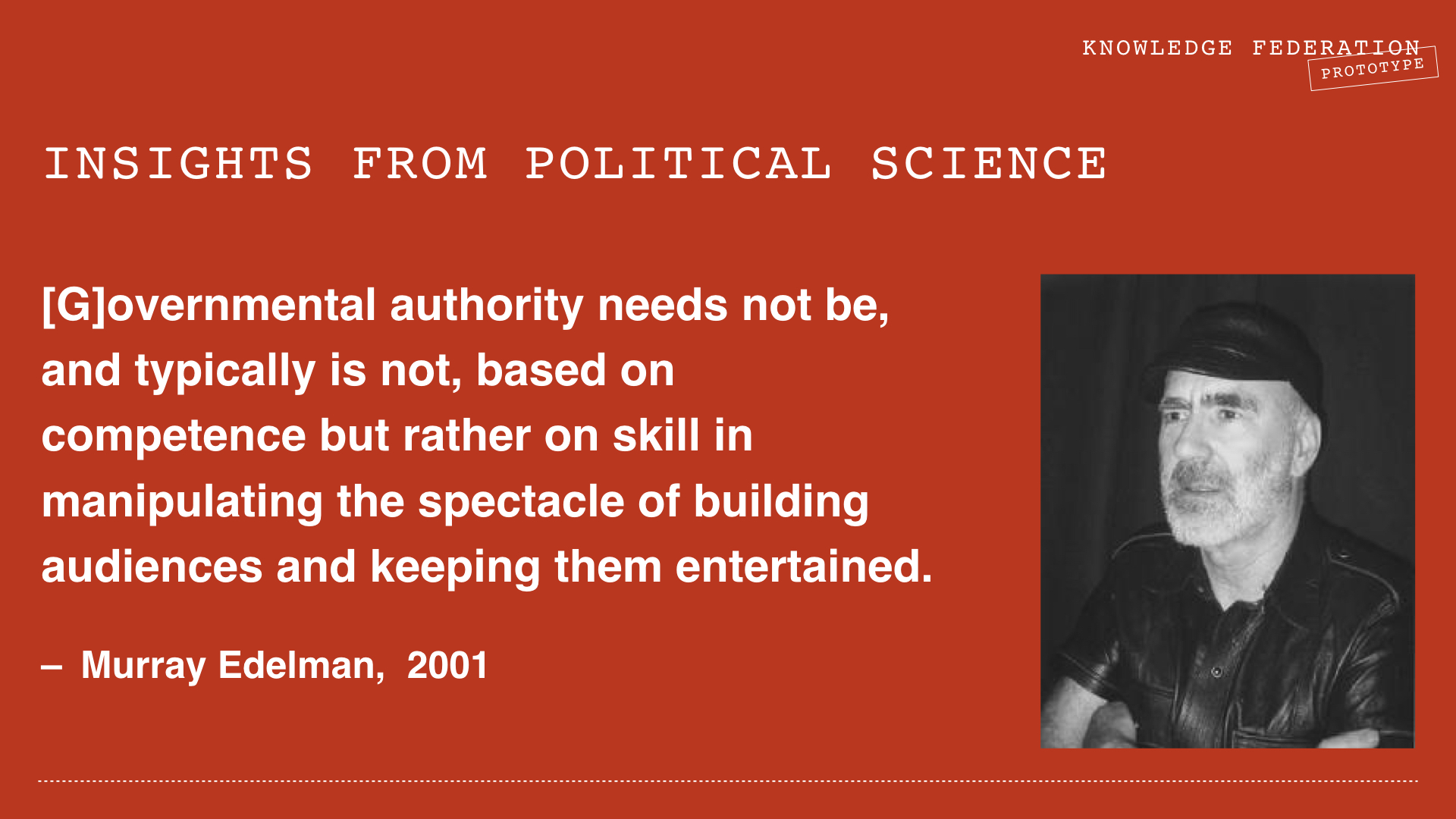Difference between revisions of "Holotopia: Socialized reality"
m |
m |
||
| Line 16: | Line 16: | ||
</div> </div> | </div> </div> | ||
| + | <b>To be continued</b> | ||
<div class="page-header" ><h2>Stories</h2></div> | <div class="page-header" ><h2>Stories</h2></div> | ||
Revision as of 23:01, 31 May 2020
Contents
- 1 H O L O T O P I A: F I V E I N S I G H T S
- 2 Socialized reality
- 2.1 Stories
- 2.2 A clue to cultural revival
- 2.3 Reality and beyond
- 2.4 "Reality" is a myth
- 2.5 "Reality" is constructed
- 2.6 "Reality" is an instrument of socialization
- 2.7 "Reality" is a product of power structure
- 2.8 Understanding socialization
- 2.9 Who keeps Galilei in house arrest
- 2.10 Socialized reality in popular culture
- 2.11 We are not yet free
- 2.12 Ideogram
- 2.13 The mirror points to a leverage point
- 2.14 Our point
- 2.15 Keywords
- 2.16 Reification, truth by convention and design epistemology
- 2.17 Information and implicit information
- 2.18 Symbolic action and prototype
- 2.19 Dialog
- 2.20 Prototypes
- 2.21 Holoscope and holotopia
- 2.22 Visual Literacy Definition
- 2.23 Key Point Dialog
H O L O T O P I A: F I V E I N S I G H T S
Socialized reality
The Enlightenment was a fundamental change—of the very way in which truth and meaning are conceived of and created—from which a sweeping "cultural revival" followed. Could a similar advent be in store for us today?
From the traditional culture we have adopted a myth incomparably more subversive than the myth of creation. This myth now serves as the foundation stone, on which the edifice of our culture has been constructed.
Galilei is once again in house arrest—but his prison has acquired a new shape, and we didn't recognize it. Culture has once again been turned into an instrument of power.
To be continued
Stories
A clue to cultural revival
As movies tend to, Alain Resnais' "My American Uncle" follows its characters through strained relationships with parents, career ups and downs and love-related hopes and disappointments. But "My American Uncle" offers also a meta-narrative, which (we propose) turns it into a new paradigm art project.
In that way, the movie federates a socially relevant insight of a researcher, neuroscientist Henri Laborit. At the end of the movie, Laborit appears on the screen in person, and summarizes this insight:
The unconscious is a formidable instrument. Not only because it holds all that we have repressed, things too painful for us to express, because we'd be punished by society. But also because all that is authorized, even rewarded by society, has been placed in our brain since birth. We're unaware of its presence, and yet it guides our actions. This unconscious, which is not Freud's, is the most dangerous. What we call the personality of an individual is built up from a grab-bag of value judgments, prejudices and platitudes. As he grows older, they become more and more rigid, less and less subject to question. Take away one single stone from this edifice, and it all crumbles. The result is anguish. And anguish stops at nothing, neither murder, nor genocide, nor war, in the case of social groups.
We are beginning to understand by what mechanism, why and how, throughout the history and in the present, the hierarchies of dominance have been established. To go to the moon, we must know the laws of gravity. Knowing the laws of gravity doesn't make us free of gravity. It merely allows us to utilize it.
Until we have shown the inhabitants of this planet the way their brain functions, the way they use it, until they know it has always been used to dominate others, there is little chance that anything will change.
Reality and beyond
Did Moses really return from Mount Sinai with ten commandments, written in stone by God himself?
For centuries, our ancestors considered this a fact. But to a modern mind, the fact that this would violate "laws of physics" takes precedence.
When Nietzsche observed, famously, that "God is dead", he did not of course mean that God physically died. Or that the belief in God lost its foundation in our culture, which was obvious. What he meant was that we, as culture, lost a range of functions that had been founded on the belief in God.
An example are principles to live by. But not the only one.
A tradition includes not only principles, but also rituals, architecture, music, norms...—by which people are (let's use this word now) socialized to think and feel and behave in a certain way. To be in a certain way.
So Nietzsche's real, subtle and all-important point was that we have rebelled, and left our "father's" home. By doing that we have acquired not only a new freedom, but also a new set of responsibilities. We must now provide for ourselves. We must become a bit like the "father" was...
"Reality" is a myth
Our contemporary culture too is founded a popular belief—that "truth" means "correspondence with reality"; that "correspondence with reality" can be rationally verified; and that "the scientific worldview" is a result of such verification, and therefore "objectively true".
"Correspondence with reality" cannot be verified
In "Evolution of Physics", Einstein and Infeld explained why "correspondence to reality" cannot be rationally verified, by using the parable of a closed watch. Einstein, furthermore, held the position that the belief that the results of our speculation or reflection correspond to reality is a common product of illusion. Both arguments are summarized and commented [here].
Since our goal is not to give a new "objectively true reality picture", but only to submit a legitimate way of looking at our theme, nothing more needs to be said.
Our culture too has been founded on a myth
It follows that our culture too is founded on a myth.
This can easily be understood, and forgiven, if one takes into account that the belief that "truth" means "correspondence with reality" is deeply engrained in our 'cultural DNA', and even in our language. When I write "worldviews", my word processor underlines the word in red. The word "worldview" doesn't have a plural; since there is only one world, there can be only one worldview—the one that corresponds to that world.
"Reality" is constructed
Another foundational myth lingers—that a "normal person" sees "reality" as it "really is"; which then of course means "as other normal people see it". This places "reality" into the hands of the socialization, tradition, or power structure.
Research has shown that what we call "reality" is constructed by our sensory organs and our culture; understanding the existence, the nature and the consequences of this construction provides us most valuable clues clue for evolving further.
Having lost its bearings in philosophy, "reality" as preoccupation migrated to biology, psychology and sociology—where the mechanisms of reality construction could be studied.
We represented them by Maturana, Piaget and Berger and Luckmann—see our commentary that begins here.
The sensation of meaning, the "aha" we experience when the details seem to fit snuggly together into a larger picture, is an indispensable constituent of our handling of knowledge, for a number of reasons. But it is not a sign that we have seen "the reality". Hence meaning needs to be used with caution, and in an informed way.
"Reality" is an instrument of socialization
"Reality" may well be understood as a concept the traditions developed for the purpose of socialization. A "normal" person, it is assumed, sees "the reality" as other normal people see it. By socialization, we mean "conditioning"; the results of uncountably many "carrots and sticks", internalized throughout our lifetime, and giving us certain automatic responses that constitute our "personality". Laboriot comments in "My American Uncle":
... the mother embracing a child, the decoration that will flatter the narcissism of a warrior, the applause that will accompany a narration of an actor. All this will free certain chemical substances in the brain and result in pleasure. (...) Finally, we need to be aware that what penetrates into our nervous system from birth and perhaps even before, in utero, the stimuli that will enter our nervous system come to us essentially from the others, and that we are the others. When we die, it will be the others that we've internalized in our nervous system, who have constructed us, who have constructed our brain, who have filled it up, that will die.
Bourdieu's theory of socialization
In his "theory of practice", Pierre Bourdieu gave us a comprehensive sociological theory of socialization. For now, let us represent it with a single word, doxa—which Bourdieu adopted from Max Weber, and whose usage dates all the way back to Plato. We mention this to suggest that doxa points to an idea that has deep roots and central function in the academia's history, which we'll come back to. Bourdieu uses this keyword to point to the experience—that the societal order of things we happen to live in constitutes the only possible one. "Orthodoxy" leaves room for alternatives, of which ours is the "right" one. Doxa ignores even the possibility of alternatives.
What makes a king "real"
The king enters the room and everyone bows. Naturally, you do that too. By nature and by culture, we humans are predisposed to do as others. Besides, something in you knows that if you don't bow down your head, you might lose it.
What is it, really, that makes the difference between "a real king", and an imposter who "only believes" that he's a king? Both consider themselves as kings, and behave accordingly. But the "real king" has the advantage that everyone else has been socialized to consider him as that.
While a "real king" will be treated with highest honors, an imposter will be incarcerated in an appropriate institution. Even though a single "real king" might have caused more suffering and destruction than all the imposters, and indeed all the historical criminals and madmen.
"Reality" is a product of power structure
Symbolic power
What strategy could be more effective for controlling us, for inhibiting our societal and cultural evolution ('keeping Galilei in house arrest'), then to construct the very worldview we collectively share and uphold as "reality"?
The story, which we have not yet told in sufficient detail, is about Bourdieu in Algeria, during Algeria's war against France for independence, and immediately after. There the circumstances allowed Bourdieu to observe how power morphed—from the traditional censorship, torture and prison, during the war, to become what Bourdieu called symbolic power, following the independence. The following vignette will suggest what Bourdieu actually saw.
Imagine a young Kabylian man who, driven by economic necessity, moved from his village to a city—only to discover that his entire way of being, which served him well, has become dysfunctional. Not only his sense of honor, but the very way he walks and talks are suddenly unappealing even to the young women from his very village—who saw something else in movies and in restaurants.
Bourdieu was reminded of his own experience—when he arrived to Paris, as an unusually gifted "hillbilly", to continue his education. He realized that the essence of power, and disempowerment, is not, and never was, as we the people tend to perceive it.
Symbolic power is part of power structure
Initially, we used to conflate symbolic power and power structure into a single concept—power structure. We later found it better to separate them—but let us now put them back together.
Throughout history, revolutions took place when people perceived the issue of justice and power in a new way, and saw themselves as unjustly disempowered. What we are witnessing here is a similar development taking place in our own time. Who 'keeps Galilei in prison' (hinders the progress of knowledge, and our evolution) today—without using any of the recognized instruments of power?
The Power Structure ideogram, shown on the right, depicts our 'political enemy' as a structure comprising power interests (represented by the dollar sign), our ideas about the world (represented by the book), and our own condition of wholeness (represented by the stethoscope).
Understanding socialization
On The Paradigm Strategy poster, which was a predecessor to holotopia (described here), the mechanism of socialization is represented by the Odin–Bourdieu–Damasio thread (which we outlined here). In what follows we highlight the main ideas.
Bourdieu's "theory of practice"
We condense it to a single keyword—"habitus". It is a generic keyword for embodied predispositions to think and act in a certain way, which tend to be transmitted directly, from body to body, as we suggested above. Someone has the habitus of a king; someone else "is" a serf, or a knight or a page. Imagine them together as comprising a symbolic turf—where each of us has a place.
Damasio's "Descartes' Error"
Bourdieu's sociological theories synergize most beautifully with the ideas of cognitive neurosurgeon Antonio Damasio.
Damasio contributes a point—deftly coded into the very title of his book "Descartes' Error"—that we are not rational decision makers. The very contents of our rational mind (our priorities, and what options we are at all capable to conceive of and consider) are controlled by a cognitive filter—which is pre-rational. And embodied.
Damasio's theory completes Bourdieu's "theory of practice", by contributing the physiological mechanism by which the body-to-body socialization to conform to a given "habitus" extends into a doxa—that the given order of things, including our habitus, is just "reality".
Odin the horse
This real-life anecdote about the turf behavior of Icelandic horses serves to make introduce an interesting way of looking at the theme of power, with large potential impact—which is the following.
We have all been socialized to live in the "reality" where some are winners (kings) and others losers (serfs). But another way to see this is possible—where all of us are losers! And where the whole absurd game is indeed a result of a pathological and atavistic human tendency—to seek domination over others.
An alternative is, of course, human development. Of exactly the kind that the Buddha, Christ and so many other humanity's teachers have been pointing to.
Who keeps Galilei in house arrest
We did not really liberate ourselves from the power structure; and from the negative socialization it engender. Our socialization only changed hands—no longer the prerogative of the kings and the clergy, it is now used to subjugate it to new power holders.
This terrain is all too familiar. The anecdotes shared below will serve to remind us how we ended up needing so much human development; and a cultural revival.
Pavlov and Chakhotin
Pavlov's experiments on dogs (for which he was awarded the Nobel Prize) can serve us as a suitable metaphor for socialization
.
After having worked with Pavlov in his laboratory, Sergey Chakhotin participated in the 1932 German elections against Hitler. He noticed that Hitler was socializing German people to accept his ideas. He practiced, and advocated, the use non-factual or implicit information to counteract Hitler's approach (see an example on the right). Adding "t" to the familiar Nazi greeting produced "Heilt Hitler" (cure Hitler).
Later, in France, Chakhotin explained his insights about socializing people in a book titled "Viole des foules par la propagande politique"—see it commented here.
Edelman and symbolic action
Already in the 1960s the researchers knew that the conventional mechanisms of democracy (the elections) don't serve the purpose they were assumed to serve (distribution of power)—because (field research showed) the voters are unfamiliar with the candidates' proposed policies, the incumbents don't tend to fulfill their electoral promises and so on. Edelman contributed an interesting addition: This does not mean that the elections don't have a purpose; it only means that their purpose is different than what's believed. Their purpose is in Edelman's parlance symbolic—which means to legitimize the existing governments and policies, by making people feel they'd been asked and included.
Have you been wondering what makes one qualified to become the president of the United States?
To help us understand the world we live in, Edelman contributed a thorough study of "politics as symbolic action". Fifty years ago.
Freud and Bernays
While Sigmund Freud was struggling to convince the European academics that we, humans, are not as rational as they liked to believe, his American nephew Edward Bernays had no difficulty convincing the American business that exploiting this characteristics of the human psyche is—good business. Today, Bernays is considered "the founder of public relations in the US", and of modern advertising. His ideas "have become standard in politics and commerce".
The four documentaries about Bernays' work and influence by Adam Curtis (click here) are most highly recommended.
Socialized reality in popular culture
As always, this core element present in our 'collective unconscious' (even if it has all too often eluded our personal awareness) has found various expressions in popular culture—as the following two examples will illustrate.
The Matrix
The Matrix is an obvious metaphor for socialized reality—where the "machines" (read power structures) are keeping people in a media-induced false reality, while using them as the power source. The following excerpt require no comments.
Morpheus: The Matrix is everywhere. It is all around us. Even now, in this very room. You can see it when you look out your window or when you turn on your television. You can feel it when you go to work... when you go to church... when you pay your taxes. It is the world that has been pulled over your eyes to blind you from the truth.
Neo: What truth?
Morpheus: That you are a slave, Neo. Like everyone else you were born into bondage. Into a prison that you cannot taste or see or touch. A prison for your mind.
Oedipus Rex
King Oedipus was not really a young man troubled by sexual attraction to his mother, as Freud may have made us believe. His problem was a conception that he was socialized to accept as reality—which drew him ever closer to a tragic destiny, as he was doing his best to avoid it.
A parable for our civilization?
We are not yet free
The task that is before us:
During the past century we learned how to harness the power of the wind, the water, the electricity and the atom. Our next task is to harness the largest power—our socialization
This power is the largest because it decides how all those other powers are used.
Ideogram
The mirror points to a leverage point
As suggested by the Enlightenment as example, the humanity's quest for knowledge has its own powerful course, which can effortlessly lead to a "change of course" and a great cultural revival.
This natural flow has recently brought us to the metaphorical mirror.
The Mirror ideogram we use to summarize the academia's situation, pointing to a course of action—in a similar way as the Modernity ideogram summarizes the situation our society or civilization is in.
Our point
We Mirror ideogram as a visual shorthand points to two fundamental recent changes in the foundations of our pursuit of knowledge. And in the academia's situation.
The end of innocence
We have learned that we are not "objective observers".
It is no longer legitimate to claim the innocence of "objective observers of reality". By seeing ourselves in the mirror, we see that it has along been just us looking at the world, and creating representations of it.
The beginning of accountability
We are no longer living in a tradition—which to our ancestors provided orientation and guidance in all relevant matters. Information has thereby acquired a new and all-important role.
The mirror symbolizes this by suggesting that when we see ourselves in the mirror, we see ourselves in the world. Hence we see ourselves as part of the world, and reponsible for it.
We must pause and self-reflect
As a symbol for the situation, which the academia's evolution so far has brought us to, the mirror demands that we interrupt the academic business as usual and self-reflect—about the meaning and purpose of our work. A genuine academic dialog in front of the mirror is the core of our practical proposal, our call to action.
Enormous gains can be made
The change of the relationship we have with information, which is the core of our proposal, is here symbolized as a perfectly feasible yet seemingly magical next step—through the mirror!
Hence our overall proposal—the way we've federated the results of The Club of Rome as summarized by Peccei—is that the academia should step through the mirror; and guide our society to a completely new reality, which awaits on the other side.
Keywords
Reification, truth by convention and design epistemology
Reification of "culture", "science", "democracy" or anything else as the existing or traditional implementations of those abstract ideas binds us to the traditional order of things, and effectively inhibits a cultural revival or paradigm change.
Truth by convention is the radical alternative. It's truth that suits the design order of things. It is the new foundation stone, to CONSISTENTLY replace reification. 'Archimedean point' for giving knowledge once again the power to 'move the world'.
Three points need to be understood: truth by convention
- makes information completely independent of "reality" and tradition
- provides a rock-solid or incontrovertible foundation
- provides a completely flexible foundation for creating truth and meaning (a convention is "true" only in the context where it's provided, and only until further notice)
In the context provided by the mirror metaphor, the truth by convention is what enables (in an academically rigorous way) the metaphorical 'step through' the mirror.
Design epistemology is an epistemology defined by convention. Concretely, it is what the Modernity ideogram is suggesting—information, and the way we handle it, are considered as pieces in a larger puzzle or puzzles. Not in the "objective reality" puzzle, but in the REAL reality...
Design epistemology is what orients knowledge work on the other side of the mirror.
Information and implicit information
Information is defined as "recorded experience", and as such it has an essential function. The Earth may appear to us like a flat surface; but someone has traveled around it; someone else has seen it from the outer space. And so we can know that the Earth is roughly a sphere.
The point of this definition is also that any form of recorded of experience is information. A chair can be (or more precisely can have an aspect of) information—being a record of human experience related to sitting, and chair making. So information can be explicit (if something is explicitly stated or claimed), or implicit (in the mores of the tradition, artifacts, beliefs, shared values etc.).
By including implicit information, we both
- give citizenship rights to mores, artifacts, customs, architecture and various other forms of cultural heritage as embodying and hence encoding implicit information, and hence rescue them from oblivion and destruction by turning them into objects of federation
- preclude deceptive, fake information, which instead of embodying human experience for the purpose of informing others, it socializes us in ways that suit the power structure.
Symbolic action and prototype
We adopted the keyword symbolic action pretty much from Murray Edelman, with minor modifications. Having been socialized to consider the existing order of things (or the power structure) as the reality, and at the same time being aware that "something must be done", we conceive our action in a symbolic way (which makes us feel we have done our duty, without really affecting the power relationships and hence having impact): We write an article; we organize a conference...
The creation of prototypes—a goal that naturally follows from the design epistemology—is the alternative. We federate information all the way into systemic prototypes, which are designed to have impact. This "restores agency to information, and power to knowledge".
Dialog
The dialog is the attitude and the manner of communication that suits the holoscope order of things. And it is also more—a strategy to re-create our collective mind, and make it capable of thinking new thoughts.
By building on the "Socratic method" or "midwifery" or "maieutics", the dialog is way to restore academia's original roots and values. By building on David Bohm's praxis of "dialogue", it acquires an agile contemporary meaning, and inherits an invaluable body of insights (see it outlined here). In Bohm's understanding, the "dialogue" is a form of cognitive and social therapy, necessary for shifting the paradigm, evolving further, and resolving the contemporary issues. Bohm conceived it as the antidote to socialization and power structure.
In addition—the dialog, as we are using this keyword, includes a spectrum of strategic and tactical tools. By designing for the dialog, we rule out certain practices that the power structure has used effectively to frustrate and hamper attempts at change. We create conventions of conduct. We use the camera as feedback... We turn events into spectacles—where the point is not to win in a discussion, but on the contrary, where the attitude to win in the discussion is derogating...
Prototypes
Holoscope and holotopia
While both holoscope and holotopia are visions and not prototypes, those visions have been developed and made concrete through a series of prototypes, as outlined on these pages. The most recent experiments are the Earth Lab Bergen and The Paradigm Strategy poster with the associated event in Oslo.
On the stage set by the Mirror ideogram, the holoscope and the holotopia represent respectively the academic and the social reality on the other side of the mirror.
Visual Literacy Definition
This prototype illustrates several ideas and tools of considerable strategic and tactical potential. The main one is to replace reification and tradition (or metaphorically 'candles') as determining the direction, and using a federated principle (rule of thumb, overarching insight). And hence "restoring agency to information, and power to knowledge"—and to the people creating them of course.
The real story may need to be told, but meanwhile, here are some preliminary sketches. So think about a whole community of researchers doing work on a theme that just couldn't be more needed by the society. And yet being virtually of no real use to the society. The underlying problem being all those inherited fundamental and institutional incongruences, which we've been talking about all along.
The story
In 1969, four visionary researchers saw the need, and initiated the International Visual Literacy Association. What exactly did they see? Three decades later, on the IVLA's annual conference which was that year in Iowa, a panel is organized, like so many times before, on the theme of visual literacy definition. What is really "visual literacy"? Ten respected members of the community proposed ten different definitions, and at that point the event ran out of time and everyone went home.
Dino was jet lagged and woke up early, and so while rolling from side to side in bed he saw how the whole issue could be handled in a very different way. In the first morning parallel session he was, by serendipity, alone in the audience with Lyda Cochran, the only surviving IVLA co-founder, and so he told her the idea. Lyda liked it, and organized a special panel for Dino to propose this idea to the IVLA elders. To the next year's conference, Dino contributed an article where the ideas were elaborated. Lyda was not present, but Dino showed her the article beforehand, and her response was enthusiastic. A result was that Dino was invited into the IVLA board, obviously on Lyda's recommendation. We mention this not to brag, but to illustrate how a completely different approach to definition, along the lines introduced here, could entirely change the impact of a community of researchers; and of the key point they have in store for the society.
A definition that points to the purpose
The proposed definition focuses on the key point, not on "factual truth" (determining what exactly "is" and "is not" visual literacy). The point is made, in the course of presentation, that while such definitions tend to be elaborate, they also tend to miss the point—which shows both to the community, and to the world beyond, why they should care.
The purpose is communicated by using the techniques outlined with the narrow frame insight. Hence it can be exported into the outer world or federated. We used the following ideogram, see it commented here.
In the above picture the implicit information meets the explicit information in a direct duel. Who wins? Since this poster is a cigarette advertising, the answer is obvious.
The purpose is all-important, but easily missed
While the official culture is focused on explicit messages and rational discourse, our popular culture is being dominated, and created, by implicit information—the imagery, which we have not yet learned to rationally decode, and counteract.
So becoming "literate" about implicit information is, as we saw above, our society's vital need. A need that is well beyond the interest in visual communication as such. And so it has turned out that this need is most easily misunderstood by the IVLA researchers themselves—who, biased by the usual "factual" orientation of academic research, "objectivity", article publication etc.—all too easily miss the point that there's something essential that needs to be communicated to the society. Arguably, a completely different institutional organization and way of working may be necessary for fulfilling the purpose—and we'll see this again and again in the examples presented within holotopia.
The eye of the elephant
So once again here we see an 'organ' of the elephant being seen, and yet ignored—owing to reification. We told the story here as a parable—pointing to the kind of difference that knowledge federation as academic (let's call it that) meta-design may make.
Key Point Dialog
As mentioned, the initial step we are proposing for holotopia development is a series of dialogs. Part of the story is to go back to the original values, and to Aristotle... Another part is to build upon the important work of David Bohm and others, as we have just seen—and by doing that to begin recreating our collective mind, as we have just seen. To prepare for this task, we have done a series of <prototypes> and experiments under the shared name Key Point Dialog.
A key point is, simply, "a way to change course"; it is an insight that can lead to a direction change in a community. When capitalized, the Key Point is the Big key point–a one that can lead to a global shift. And so the challenge that motivates this prototype is to structure the communication within a community so that its members jointly see the key point.
David Bohm's original idea, his "dialogue", is a slow-moving event. It is designed not to have a purpose; the participants check all their agendas at the entrance door, and do their very best to let the "dialogue" take its own spontaneous course.
What we did was to, metaphorically speaking, turn Bohm's "dialogue" into a high-energy cyclotron.
Long story short, the key point dialog is composed of a community's opinion leaders (the people who are qualified, trusted, by their role accountable... to set directions). They are physically placed into a context, which symbolically places them into the context of our times and conditions (by federating relevant insights). In the center of the circle a piece of evidence is placed, which challenges the current direction and requires a new one. An 'amplifier' (implemented by suitable media technology) is also present in space and online, so that if and when the circle begins to 'resonate' with new tones, as 'stricken' by the evidence provided in the context, they are spread into the community, at which point the dialog becomes properly public.
Several runs and improvements of the key point dialog were implemented over the years, of which we name the following:
- Municipality key point dialogs in Norway (KommuneWiki project) was developed to add the capability to reassess the dominant (power structure-induced) values and lifestyle patterns to the conventional social-democratic repertoire of Norwegian municipalities (which bear the suggestive name "kommune" or communes)
- The Cultural Revival Dialog Zagreb 2008 had all the offline elements described above, and the explicit goal to address Aurelio Peccei's core proposition, which motivates holotopia
- The Tesla and the Nature of Creativity TNC2015 dialog in Belgrade added also the 'amplifier' or media infrastructure—represented by video streaming, photography, TV, and a public dialog organized on DebateGraph.
See the summary here.


